Research Article - (2024) Volume 1, Issue 1
Influence of Emissivity on Airframe Surface Temperature Under Transient Thermal Conditions: A Finite Element Analysis Using ANSYS APDL
Received Date: Nov 08, 2024 / Accepted Date: Dec 12, 2024 / Published Date: Dec 20, 2024
Copyright: ©2024 Muri Venkateswara Karthik. This is an open-access article distributed under the terms of the Creative Commons Attribution License, which permits unrestricted use, distribution, and reproduction in any medium, provided the original author and source are credited.
Citation: Karthik, M, V. (2024) Influence of Emissivity on Airframe Surface Temperature Under Transient Thermal Conditions: A Finite Element Analysis Using ANSYS APDL. Ther Res: Open Access, 1(1), 01-06.
Abstract
This study explores the influence of emissivity on the surface temperature of airframes under transient thermal conditions, employing ANSYS APDL for simulation. The research is driven by the critical need for effective thermal management in airframes, which are essential structural components in aerospace and automotive industries. The analysis was conducted on a hollow steel airframe with an external diameter of 250 mm, an internal diameter of 248 mm, and a length of 300 mm. The model was discretized using solid-8 node 70 element, with a mesh size of 1 mm. A constant heat flux of 10,000 W/m2 was applied to the airframe’s wall over a period of 300 seconds, with a time step of 1 second, to simulate the heat transfer conditions. The study systematically varied the emissivity from 0.05 to 1, in increments of 0.05, to assess its impact on the airframe's surface temperature. Results indicate a clear inverse relationship between emissivity and surface temperature. As emissivity increases, the airframe's ability to emit thermal radiation improves, leading to a significant reduction in surface temperature. This effect is particularly pronounced at higher emissivity values, where a substantial decrease in surface temperature was observed. The findings underscore the pivotal role of emissivity in thermal management. Airframes with higher emissivity demonstrate enhanced heat dissipation capabilities, which is critical for maintaining structural integrity under high thermal loads. The study provides valuable insights for the design and optimization of airframes, particularly in applications where precise thermal regulation is essential. By selecting materials with appropriate emissivity characteristics, engineers can achieve superior thermal performance, thereby improving the safety, durability, and efficiency of airframes in demanding operational environments.
Introduction
In the realm of modern engineering, the thermal management of structural components is a fundamental concern that directly influences the performance, reliability, and safety of mechanical systems. Among these components, airframes, which constitute the primary structural framework in aerospace and automotive applications, are particularly susceptible to thermal stresses and temperature fluctuations. These thermal challenges can induce material degradation, structural deformation, and even catastrophic failure if not adequately addressed. Consequently, understanding the thermal behavior of airframes, especially in terms of surface temperature regulation, is of paramount importance. Emissivity, a material property that quantifies a surface's ability to emit thermal radiation, plays a critical role in determining the surface temperature of structures exposed to high heat fluxes. In thermal management, materials with higher emissivity are more efficient at radiating heat, which leads to lower surface temperatures.
Conversely, materials with lower emissivity tend to retain more heat, resulting in elevated surface temperatures. This property is crucial in applications where thermal dissipation is essential for the optimal performance and longevity of the structure, such as in high-speed aircraft, spacecraft, and other vehicles that operate in extreme thermal environments. The primary objective of this research is to investigate the effect of varying emissivity on the surface temperature of airframes. To achieve this, a hollow steel airframe was modeled and subjected to a transient thermal analysis using ANSYS APDL, a robust finite element analysis tool widely used in the industry. The model simulates real-world conditions by applying a constant heat flux to the airframe’s surface, followed by a series of analyses in which the emissivity is systematically varied. The resulting surface temperatures are recorded and analyzed to elucidate the relationship between emissivity and thermal response. This study is structured to build a comprehensive understanding of how emissivity influences surface temperature under transient thermal conditions. Initially, the airframe is modeled with specific geometric and material properties, and a baseline temperature response is established under a constant heat flux. Following this, the study examines the impact of different emissivity values on the thermal performance of the airframe through a series of simulations.
The results reveal a pronounced inverse relationship between emissivity and surface temperature, demonstrating that higher emissivity significantly enhances the airframe’s ability to dissipate heat. The implications of these findings are significant for the engineering design of airframes, particularly in contexts where precise thermal control is critical. By selecting materials with optimal emissivity, engineers can improve the thermal management of airframes, leading to better performance, greater structural integrity, and extended operational lifespans.
Literature Survey
Thermal management in aerospace applications is a critical challenge due to the high heat flux and extreme thermal loads experienced during operations. This study investigates the role of emissivity in enhancing the thermal dissipation capabilities of airframes, with insights drawn from previous research in the field.
[1] emphasise the need for integrating thermal management into system-level designs, particularly for aerospace systems facing transient heat loads. They highlight the potential of adaptive power and thermal management strategies, which resonate with the study's focus on enhancing emissivity to improve thermal regulation in airframes.
[2] provide a comprehensive review of active and passive thermal management technologies, emphasising their role in addressing the thermal challenges of more electric aircraft (MEA) and high heat flux environments. Their insights on advanced materials and cooling techniques directly align with the use of emissivity as a parameter to optimise thermal management in airframes.
[3] explore innovative cooling solutions for hypersonic reentry vehicles, including passive and active approaches. The study’s f indings on global thermal management and the use of high conductivity carbon fibres underscore the significance of material properties such as emissivity in regulating surface temperatures.
[4] reviews high-heat-flux cooling technologies, including phase change cooling, microchannels, and jet impingement. The study discusses the limitations of conventional cooling techniques and the need for innovative hardware solutions, aligning with the exploration of emissivity’s role in improving thermal performance.
[5] examine thermal management systems for civil aircraft engines, focusing on the evolution of gas turbine engine cooling technologies. Their work underscores the challenges of managing increased thermal loads in modern aero engines, emphasising the need for optimised designs and materials with superior heat dissipation capabilities, such as those influenced by emissivity variations.
These studies collectively emphasise the importance of advanced thermal management strategies, material innovations, and system-level optimizations, providing a foundation for exploring emissivity’s impact on airframe surface temperatures.
Methodology
This study employs a detailed simulation-based approach to examine the impact of emissivity on the surface temperature of a hollow airframe under transient thermal conditions. The methodology is designed to ensure that the findings are scientifically robust and applicable to real-world engineering scenarios, particularly in aerospace. The following steps outline the comprehensive process proposed in this research:
Model Preparation
• Geometry Definition
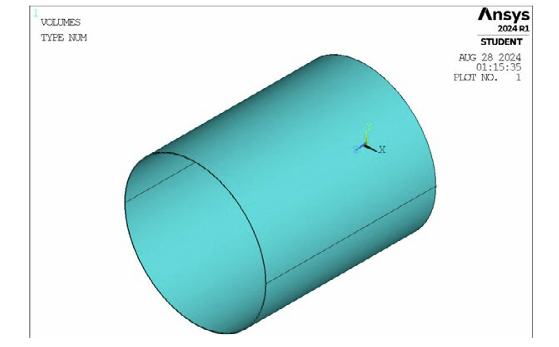
Figure 1: Representation of the Airframe model which is to be analysed.
A hollow cylindrical airframe was selected as the subject of the study, modeled with an external diameter of 250 mm, an internal diameter of 248 mm, and a length of 300 mm. These dimensions were chosen to represent a typical airframe structure used in aerospace applications, providing a realistic basis for the simulation and ensuring that the results are applicable to actual engineering scenarios.
• Element Type Selection:
The airframe was discretized using the solid-8node70 element type in ANSYS APDL. This element type is specifically chosen for its ability to accurately model heat transfer and temperature gradients within a three-dimensional domain, making it ideal for analyzing the thermal behavior of solid structures under transient conditions.

Figure 2: Diagram Representing Element Type Selection.
• Meshing:

Figure 3: Air Frame after meshing.
A fine mesh was generated using the volume sweep method, with all area sizes set to 1 mm. This high-resolution mesh ensures the accurate capture of localized thermal effects and temperature gradients across the airframe, which is crucial for understanding the detailed thermal response of the structure.
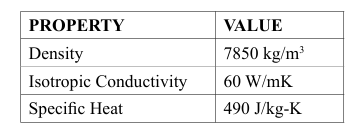
• Boundary Conditions
A uniform heat flux of 10,000 W/m² was applied to the external surface of the airframe. This boundary condition replicates the intense thermal loads experienced by airframes during high speed flight or re-entry into the Earth's atmosphere, where external surfaces are subjected to significant thermal radiation and convective heating.
• Element Type Selection:
The airframe was discretized using the solid-8node70 element type in ANSYS APDL. This element type is specifically chosen for its ability to accurately model heat transfer and temperature gradients within a three-dimensional domain, making it ideal for analyzing the thermal behavior of solid structures under transient conditions.
2. Material Properties and Boundary Conditions
• Material Properties:
Steel was selected as the material for the airframe, given its widespread use in aerospace structures and favourable thermal properties. The thermal properties of steel, including thermal conductivity and specific heat capacity, were defined within ANSYS APDL to simulate heat transfer accurately.
3. Transient Thermal Analysis
• Analysis Setup
A transient thermal analysis was proposed to be conducted over a period of 300 seconds to capture the dynamic thermal response of the airframe. The analysis would be divided into 300 time steps, each representing 1 second, allowing for detailed observation of the temperature evolution on the airframe's surface throughout the heat flux application.
• Initial Condition
The initial temperature of the airframe was uniformly set to 300K, ensuring that the observed thermal effects would be solely due to the applied heat flux and the varying emissivity values. This setup isolates the influence of emissivity on the airframe's thermal performance, providing a clear understanding of its impact.
4. Emissivity Variation and Simulation Series
• Emissivity Values
The study proposed to vary the emissivity of the airframe's surface across a range of values from 0.05 to 1, in increments of 0.05. An additional simulation with an emissivity value of 0 would serve as a baseline for comparison. Each emissivity value would be applied to the external surface of the airframe, and the corresponding thermal response would be recorded.
• Simulation Execution
For each emissivity value, a separate simulation would be executed under identical conditions, with the only variable being the emissivity parameter. This approach would ensure that any observed differences in surface temperature are directly attributable to changes in emissivity, providing a clear understanding of its role in thermal management.
5. Data Collection and Analysis
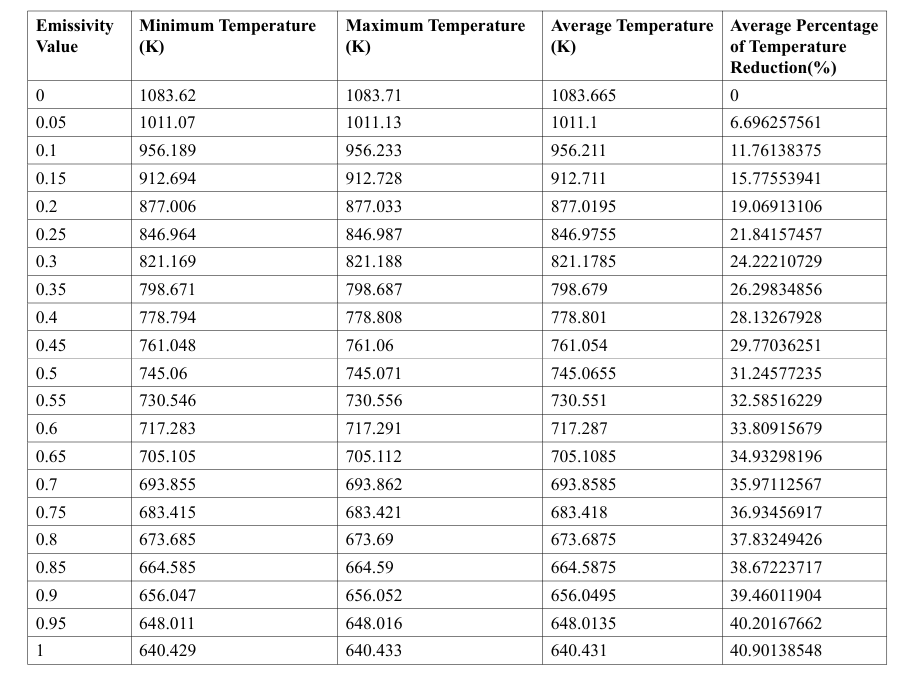
5.1 Temperature Data
Upon completion of each simulation, the minimum, and maximum surface temperatures of the airframe would be recorded. These temperature metrics would provide a comprehensive overview of the airframe's thermal behaviour under varying emissivity conditions, allowing for detailed analysis of how emissivity influences thermal performance.
5.2 Percentage Change Calculation
The temperature data would be further analyzed to calculate the percentage change in surface temperatures relative to the baseline emissivity (0). This analysis would highlight the degree to which emissivity affects the thermal performance of the airframe, offering insights into its potential for improving thermal management in high-temperature environments.
5.3 Statistical Analysis
A statistical analysis of the temperature differences and percentage changes would be performed to identify trends and correlations between emissivity and surface temperature. This analysis would provide valuable insights into the thermal management capabilities of different emissivity levels.
6. Graphical Representation
6.1 Graph Construction
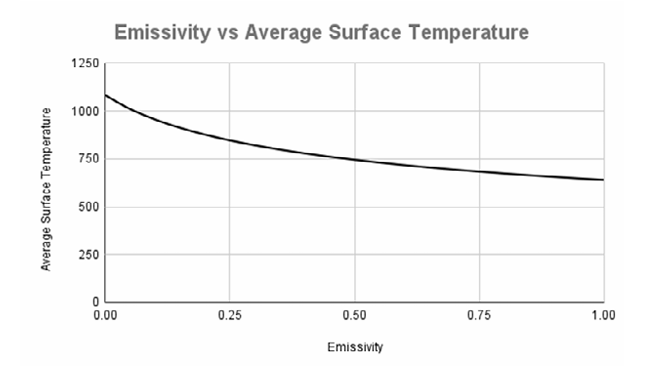
Figure 4: Graph Plotted for Emissivity vs Average Surface Temperature.
A graph is plotted to visually depict the relationship between emissivity and average surface temperature. The x-axis represents the emissivity values, while the y-axis displays the average surface temperature. This graphical representation facilitates a clear understanding of the inverse relationship between emissivity and surface temperature, with higher emissivity values corresponding to lower surface temperatures.
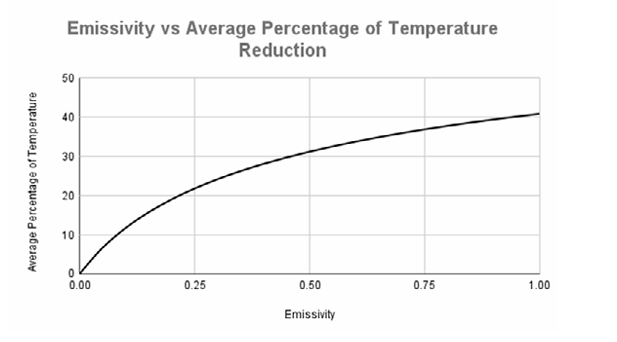
Figure 5: Graph plotted for Emissivity vs Average Percentage of Temperature Reduction.
A graph is plotted to visually depict the relationship between emissivity and the average percentage of temperature reduction. The x-axis represents the emissivity values, while the y-axis displays the average percentage of temperature reduction. This graphical representation facilitates a clear understanding of the relationship between emissivity and temperature reduction, with higher emissivity values corresponding to greater reductions in temperature.
6.2 Interpretation
The graph was analyzed to interpret the impact of emissivity on thermal performance. The trend line demonstrates that as emissivity increases, the average surface temperature of the airframe decreases, confirming the hypothesis that higher emissivity enhances heat dissipation. Additionally, the graph shows that higher emissivity values are associated with a greater percentage of temperature reduction. These findings align with theoretical predictions and provide empirical evidence supporting the role of emissivity in thermal management.
7. Validation and Verification
7.1 Model Validation
The simulation model would be validated by comparing the baseline results (emissivity = 0) with theoretical predictions on the thermal response of steel airframes under similar conditions. This validation step would ensure that the model accurately represents the physical phenomena, lending credibility to the simulation results.
7.2 Sensitivity Analysis
A sensitivity analysis was initially planned to assess the influence of mesh size and time step on the accuracy of the results. However, this step was not conducted as part of the current study. Future research may incorporate this analysis to further validate and refine the simulation outcomes.
Results and Discussions
The effect of radiation on the wall temperature of airframes was studied by varying the emissivity values. Emissivity is a measure of a material's ability to emit thermal radiation. The study showed that as the emissivity value of the airframe material increases, the wall temperature decreases and the percentage reduction in temperature increases. The study concludes that increasing the emissivity of the airframe material leads to a significant decrease in wall temperature and a greater percentage of temperature reduction. This relationship can be attributed to the fact that higher emissivity materials are more efficient in emitting thermal radiation, thereby reducing the heat retained on the surface. In practical applications, selecting materials with higher emissivity can be a strategic approach to managing thermal loads on airframes, particularly in environments where thermal radiation plays a significant role in the overall heat balance. This can enhance the thermal management and performance of the airframe, potentially leading to improved safety and durability.
References
1. Doty, J., Yerkes, K., Byrd, L., Murthy, J., Alleyne, A., Wolff, M., ... & Fisher, T. S. (2017). Dynamic thermal management for aerospace technology: review and outlook. Journal of Thermophysics and Heat Transfer, 31(1), 86-98.
2. Lv, Y. G., Zhang, G. P., Wang, Q. W., & Chu, W. X. (2022). Thermal management technologies used for high heat flux automobiles and aircraft: A review. Energies, 15(21), 8316.
3. Esser, B., Barcena, J., Kuhn, M., Okan, A., Haynes, L., Gianella, S., ... & Tanno, H. (2016). Innovative thermal management concepts and material solutions for future space vehicles. Journal of Spacecraft and Rockets, 53(6), 1051 1060.
4. Mudawar, I. (2001). Assessment of high-heat-flux thermal management schemes. IEEE transactions on components and packaging technologies, 24(2), 122-141.
5. Jafari, S., & Nikolaidis, T. (2018). Thermal management systems for civil aircraft engines: Review, challenges and exploring the future. Applied Sciences, 8(11), 2044.



